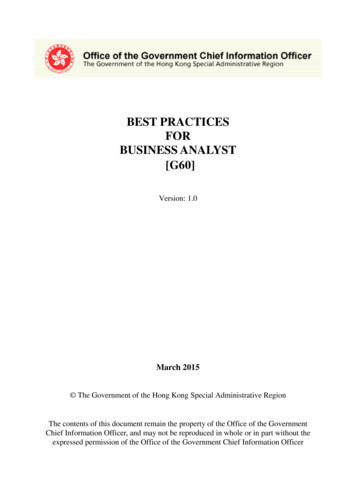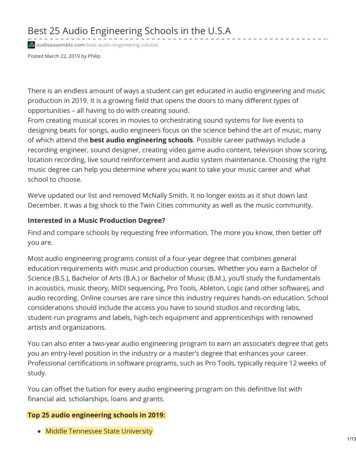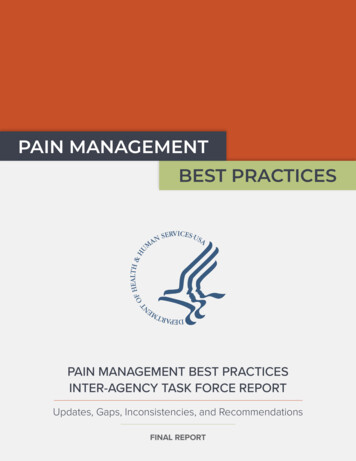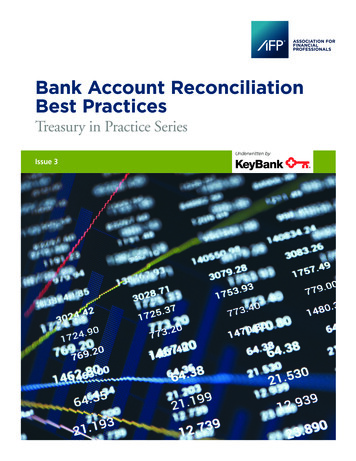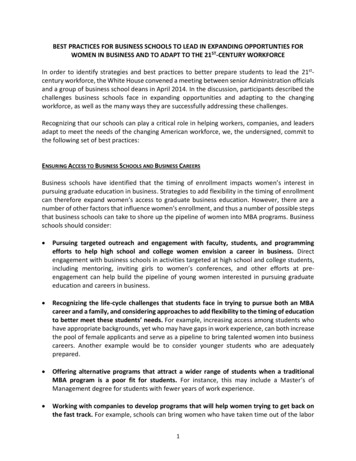
Transcription
BEST PRACTICES FOR BUSINESS SCHOOLS TO LEAD IN EXPANDING OPPORTUNTIES FORWOMEN IN BUSINESS AND TO ADAPT TO THE 21ST-CENTURY WORKFORCEIn order to identify strategies and best practices to better prepare students to lead the 21stcentury workforce, the White House convened a meeting between senior Administration officialsand a group of business school deans in April 2014. In the discussion, participants described thechallenges business schools face in expanding opportunities and adapting to the changingworkforce, as well as the many ways they are successfully addressing these challenges.Recognizing that our schools can play a critical role in helping workers, companies, and leadersadapt to meet the needs of the changing American workforce, we, the undersigned, commit tothe following set of best practices:ENSURING ACCESS TO BUSINESS SCHOOLS AND BUSINESS CAREERSBusiness schools have identified that the timing of enrollment impacts women’s interest inpursuing graduate education in business. Strategies to add flexibility in the timing of enrollmentcan therefore expand women’s access to graduate business education. However, there are anumber of other factors that influence women’s enrollment, and thus a number of possible stepsthat business schools can take to shore up the pipeline of women into MBA programs. Businessschools should consider: Pursuing targeted outreach and engagement with faculty, students, and programmingefforts to help high school and college women envision a career in business. Directengagement with business schools in activities targeted at high school and college students,including mentoring, inviting girls to women’s conferences, and other efforts at preengagement can help build the pipeline of young women interested in pursuing graduateeducation and careers in business. Recognizing the life-cycle challenges that students face in trying to pursue both an MBAcareer and a family, and considering approaches to add flexibility to the timing of educationto better meet these students’ needs. For example, increasing access among students whohave appropriate backgrounds, yet who may have gaps in work experience, can both increasethe pool of female applicants and serve as a pipeline to bring talented women into businesscareers. Another example would be to consider younger students who are adequatelyprepared. Offering alternative programs that attract a wider range of students when a traditionalMBA program is a poor fit for students. For instance, this may include a Master’s ofManagement degree for students with fewer years of work experience. Working with companies to develop programs that will help women trying to get back onthe fast track. For example, schools can bring women who have taken time out of the labor1
force into executive MBAs, or develop robust relaunch programs that allow women toreintegrate into career pathways. Targeting financial support in order to ensure that business school is a viable investmentfor a range of students, especially those with a lower earnings profile.BUILDING A BUSINESS SCHOOL EXPERIENCE THAT PREPARES STUDENTS FOR THE WORKFORCE OF TOMORROWFuture business leaders must be prepared to lead in a workplace with changing demographics.To that end, discussants acknowledged that curricula and business school experiences shouldreflect the diversity of workers and leaders, the challenges that leaders face today and in thefuture, and the organizational challenges of the modern economy. Best practices for creating acurriculum and business school experience to educate leaders in the 21st century include: Modernizing the curriculum to educate students on how to lead an organization that bestutilizes the diverse talents of employees, including those who are trying to balance workand caregiving responsibilities. For example, curricula should highlight the role of workplaceflexibility in recruitment, retention, and productivity, as well as the relationship between suchpolicies and business profitability and success. Including all students in the conversation surrounding work, caregiving, and family issues.By actively encouraging or requiring men to participate, it is easier both to ensure that theseissues and conversations do not create unintended gender gaps and to reap the benefits tothe community and the students of having all students engaged in the conversation. Identifying how inequalities in students’ backgrounds and learning styles may impact theculture and identify potential solutions. For example, the balance of required courses in thefirst term may impact the norms and culture in ways that schools may want to explicitlyconsider. Similarly, implicit biases may mean that subtle changes in how material is presentedmay impact who succeeds at it. Ensuring that a diverse group of leaders and leadership styles are brought into theclassroom. For example, providing a single place for faculty and students to identify speakersinvited to campus may make it easier to know whether a wide range of styles are beingbrought into the community. Making case studies more representative and ensuring that they reflect modernworkplaces. For example, showing diversity in leaders solving a wide range of problems isimportant to illustrate the wide range of diversity in the business community. This includesshowing women and minorities in more significant line management roles and/or as the mainprotagonist in the case.2
Making students aware of gender-based differences in negotiation strategy,communication, and assertiveness that can arise in certain contexts and circumstances.Schools should also make students aware of and create legitimacy for different styles acrossboth men and women, in addition to creating space for different approaches to succeed. Facilitating mentorship and sponsorship opportunities, especially for those who may havea more difficult time finding mentors or sponsors. Ensuring that activities outside of the classroom, such as clubs, trips, and events, areinclusive and provide leadership opportunities for a diverse group of students.ENSURING CAREER SERVICES THAT GO BEYOND THE NEEDS OF TRADITIONAL STUDENTSBusiness schools offer excellent career services for traditional students. The future workplacerequires a holistic view of recruiting, and business schools can play a vital role in supportingindividuals throughout their careers, especially those taking a nonlinear career path. To that end,business schools should consider: Encouraging employers to discuss workplace flexibility options during the recruitingprocess. For example, students should be informed of their options, since there may be moreflexibility than they assume. Expanding career services to recent graduates and alumni, potentially at the same level ofquality and effectiveness as those provided to current students. Business schools provide anatural link between students, alumni, and the business community, and can help studentstrying to make career changes or recharge or relaunch their career in much the same waythat they help students transition to their first job following business school. Providing opportunities to learn at all life stages, to keep essential competencies current,and to accelerate career growth, including through refresher courses. For example, schoolscan provide a vital source of current industry knowledge for older alumni seeking to rechargeor relaunch their careers after taking time off due to family or other obligations. Moregenerally, alumni may wish to step on and off the fast track and may turn to their alma materto get up to speed on needed competencies. Helping to facilitate the reentry of those who have taken time out of the labor force. Forexample, business schools, through relationships with businesses interested in hiring thosewho have left the labor force, can help make students aware of and facilitate thedevelopment of returnship programs and other effective relaunch programs.3
EXEMPLIFYING HOW ORGANIZATIONS SHOULD BE RUNFinally, business schools have a responsibility to set a good example by ensuring an equitableworkplace that supports a diverse faculty and staff, and so should consider: Investigating and addressing the gender gap in faculty hiring, promotion, and pay. Ensuring diversity in leadership positions within the school, including on advisory boards. Actively encouraging and rewarding research and discussion on women in the workplace,workplace flexibility, and working families. Considering adopting right-to-request policies that let workers know that they may requestthe accommodations and flexibility they need. While such policies do not guarantee workersthat they will get flexibility, they require managers to consider such requests and encourageemployees to make the requests that they believe will help them succeed. Engendering explicit discussions on climate and tone. Providing adequate supports for students, faculty, and staff with caregiving responsibilities. Recognizing the importance of value, tone, and a culture of inclusiveness in creating acampus where a diverse set of students and faculty and staff can thrive. A community thatrecognizes the values of all members of the community and fosters open dialogue toencourage the community to be more inclusive can better support the success of all membersof the community. Recognizing the challenges presented by implicit discrimination and identify solutions toaddress it.4
SignersBabson CollegeTepper SchoolUniversityGraduate School of Business, Stanford UniversityofBusiness,CarnegieMellonCollege of Business Administration, Texas A&MUniversity-KingsvilleSchool of Business, Clarkson UniversityNeeley School of Business, Texas Christian UniversityClemson University College of Business andBehavioral Science and Clemson University MBAProgramsJerry S. Rawls College of Business, Texas TechUniversityA.B. Freeman School of Business, Tulane UniversityColumbia Business School, Columbia UniversitySchool of Business, University of ConnecticutJohnson Graduate School of Management, CornellUniversityWalter A. Haas School of Business, University ofCalifornia BerkeleyFuqua School of Business, Duke UniversityGraduate School of Management, University ofCalifornia DavisGoizueta Business School, Emory UniversityMcDonough School of Business and its eorgetown UniversityJohn E. Anderson School of Management, Universityof California Los AngelesBooth School of Business, University of ChicagoScheller College of Business, Georgia Institute ofTechnologyC.T. Bauer College of Business, University of HoustonCollege of Business, University of Illinois at UrbanaChampaignGeorge Washington School of Business, GeorgeWashington UniversityHenry B. Tippie College of Business, University of IowaHarvard Business School, Harvard UniversitySchool of Management, Marist CollegeRobert H. Smith School of Business, University ofMaryland, College ParkSloan School of Management,Institute of TechnologySchool of Business, University of MiamiMassachusettsStephen M. Ross School of Business, University ofMichiganEli Broad College of Business, Michigan StateUniversityCarlson School of Management, University ofMinnesotaKellogg School of Management, NorthwesternUniversityNew York University Stern School of BusinessKenan-Flagler Business School, University of NorthCarolina at Chapel HillSmeal College of Business, Pennsylvania StateUniversityThe Wharton School, University of PennsylvaniaDavid Eccles School of Business, University of UtahKrannert School of Management, Purdue UniversityWisconsin School ofWisconsin-MadisonJesse H. Jones Graduate School of Business, RiceUniversityBusiness,UniversityDarden School of Business, University of VirginiaRutgers Business School, Rutgers University5of
Owen Graduate School of Management, VanderbiltUniversitySchool of Business, Wake Forest UniversityOlin Business School, Washington University in St.LouisYale School of Management, Yale University6
Aug 05, 2015 · that business schools can take to shore up the pipeline of women into MBA programs. Business . and programming efforts to help high school and college women envision a career in business. Direct engagement with business schools in activities targeted at high school and college st






